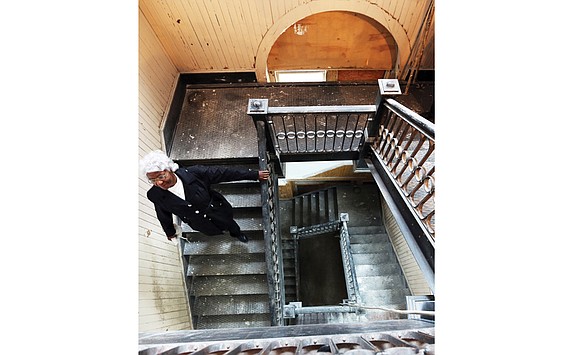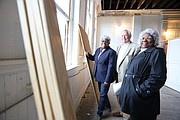Reclaiming history
St. Luke building, first home of Maggie L. Walker’s bank, is being turned into upscale apartments to spur development in Gilpin Court
Jeremy M. Lazarus | 4/28/2017, 12:36 p.m.

Upscale apartments are taking shape in the long-empty St. Luke Building, the once vital four-story headquarters of a mutual aid society where renowned Richmond businesswoman Maggie L. Walker once had a bank.
The owners, Margaret Stallings and her daughter Wanda Stallings, are moving ahead with a $3.5 million venture to install 12 large apartments in the historic landmark building at 900 St. James St. in Gilpin Court.
Call it a surprising development — and the biggest in decades — for an area largely occupied by a public housing community notorious for poverty, gunfire and crime on the north edge of Jackson Ward and Downtown.
Instead of seeing a wasteland, the Stallings family sees an opportunity to lead the revitalization of a down-at-the-heels section of the city that has only one way to go: Up.
“My brother, Ronald Stallings, has led the redevelopment of South Jackson Ward,” Wanda Stallings said, “and I want to lead the redevelopment of North Jackson Ward,” as the city has dubbed the Gilpin Court area.
The two areas are separated by an interstate highway, which in the 1950s was cut through what was then the center of Richmond’s African-American community.
To get this development underway and leapfrog largely stalled public plans for revitalizing the Gilpin Court area, the Stallings have partnered with developer Charles E. Ayers Jr., the owner of River City Ventures LLC, which is engaged in creating homes and apartments in The Fan, Church Hill and Hopewell.
“Sure we are pioneering,” Mr. Ayers said, “but we think this is a start to creating a better future for this area.”
The Stallings family owns 5 acres of land in the area. The success of this project would enable them to make plans for additional residential and retail development on what is largely vacant property, he said.
Backed by financing from Chesapeake Bank, Mr. Ayers said the St. Luke plans call for four one- and two-bedroom apartments with an average monthly rent of $1,100 to be completed in each of the three top floors. He said he is seeking to attract a medical services provider to the building’s first floor.
The exterior will be fenced and include on-site parking and space for a community garden and other activities. A fountain that was once part of the property also will be reinstalled, said Wanda Stallings.
The project also will involve restoring for residential use an adjacent duplex at 902 St. James St. The smaller building once served as temporary housing for salesmen, bank employees and visiting officials of the Independent Order of St. Luke.
The interior of the historic St. Luke building is in surprisingly excellent condition, with original wooden floors and windows, high ceilings and other coveted features of older buildings in the city.
For the past few months, Mr. Ayers has been repairing exterior damage and getting the interior ready for construction. He said work was to start this week on the yearlong effort, although Wanda Stallings and Mr. Ayers said City Hall now is requiring them to obtain a special use permit.
“We may be able to keep the work going while we go through that process,” he said. “Everyone is eager for us to get that permit.”
The building dates to 1903, according to the National Park Service, and was one of the first big projects that Mrs. Walker undertook after taking over leadership of the Independent Order of St. Luke.
Originally organized in Baltimore after the Civil War, the burial insurance and mutual aid society moved to Richmond in the 1890s, a few years before Mrs. Walker was elected secretary, a position similar to executive director.
The grander building replaced the house that stood on the site and was the order’s original home in Richmond, according to the National Park Service.
When the building was opened, it had three stories. A fourth story was added in 1919. It served as the first home of the St. Luke Penny Savings Bank, the financial institution that Mrs. Walker chartered, ultimately renamed and served as president or chairman of the board until her death in 1934.
Mrs. Walker has been enshrined in history books as the first African-American woman to charter and lead a bank in the United States. The Stallings family found many of her papers from the time in the St. Luke Building and are seeking to donate them to the Smithsonian’s National Museum of African American History and Culture in Washington.
By 1905, the bank moved to 112 W. Broad St. in rented space that also included a department store that Mrs. Walker established on behalf of the order.
By 1911, as the store foundered, the order relocated the bank to a building it purchased at 112 E. Broad St. and later to 1st and Marshall streets, where its current iteration, Consolidated Division of Premier Bank, is located.
The Stallings family has owned the St. Luke building for more than 45 years, one of the dozens of pieces of property in Jackson Ward that James Stallings Sr., the family’s late patriarch, acquired as values fell. The declining Independent Order of St. Luke sold the property around 1971 to Mr. Stallings and moved to smaller, rented quarters before it finally closed.
For nearly 20 years, the headquarters served as the home of the Richmond Community Action Program, now CAP-UP, but has been vacant since.
Wanda Stallings has long sought to secure a new use for the building and to spark revitalization of the area. Her efforts of the past four years to redevelop the property finally gained traction last year when a friend connected her with Mr. Ayers.
The St. Luke building development also could help push the Richmond Redevelopment and Housing Authority to move on its own stalled redevelopment plans for Gilpin Court.
For years, RRHA has been buying most of the remaining private holdings in the area and razing buildings, but it has taken no steps to begin construction.
Last year, RRHA gained approval from Richmond City Council to acquire the former Baker School building and to have a nonprofit partner turn the building into 52 replacement apartments for tenants now living in Fay Towers. However, that effort has stalled over financing, the Free Press was told.
Wanda Stallings is hoping that her development will show RRHA and the city what can be accomplished.
If the school building can be redone, she said, that would improve the value of all properties and add to the momentum in the neighborhood.







